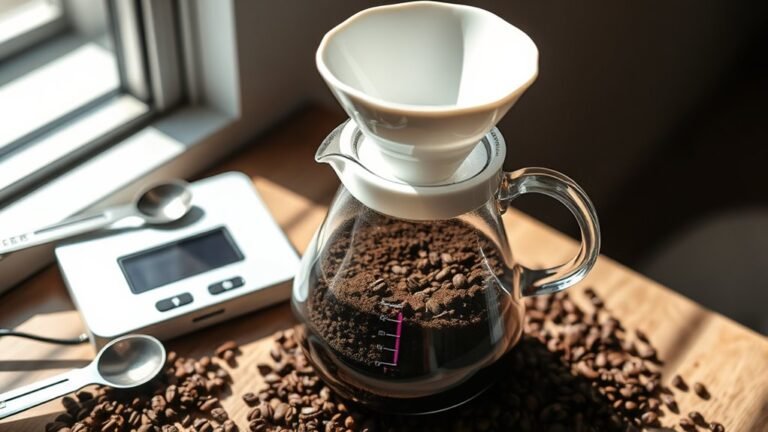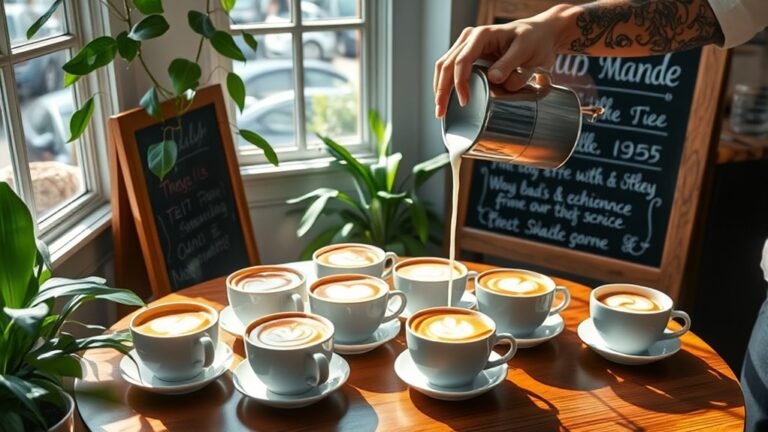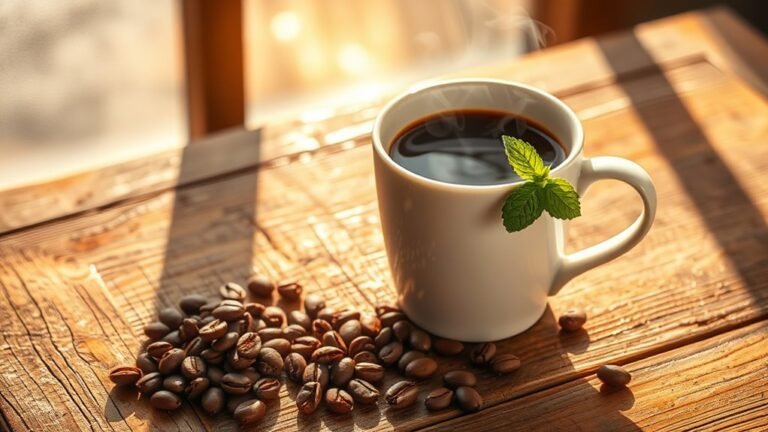The Best Decaf Coffee for Pour-Over
If you want the best decaf coffee for pour-over, choose beans decaffeinated through Swiss Water or CO2 processes for clean flavor. Opt for medium roast single-origin beans from regions known for bright, fruity, or chocolatey profiles to preserve complexity. Grind fresh to a medium consistency and brew with water between 195°F and 205°F to highlight nuanced tastes. Mastering these details will elevate your decaf pour-over experience. Keep exploring to uncover top brands and brewing tips.
Understanding the Decaffeination Process

Although decaf coffee aims to reduce caffeine content, the process involved is quite complex and varies depending on the method used. You’ll find several decaffeination techniques—like Swiss Water, CO2, and solvent-based methods—each designed to extract caffeine while preserving flavor. Understanding these methods helps you appreciate the decaf benefits, especially if you want to avoid caffeine effects such as jitters or disrupted sleep. The Swiss Water Process, for example, uses water and osmosis to remove caffeine without chemicals, appealing if you prioritize natural methods. Meanwhile, CO2 extraction targets caffeine selectively, maintaining much of the bean’s character. By knowing how decaf coffee is processed, you empower yourself to choose brews that align with your desire for freedom from caffeine’s stimulating impact, without sacrificing a rich, satisfying cup.
What Makes a Decaf Coffee Ideal for Pour-Over
When you’re selecting a decaf coffee for pour-over brewing, the bean’s origin, roast profile, and grind consistency all play vital roles in achieving a balanced and flavorful cup. You’ll want beans from regions known for nuanced flavor, as decaf flavor can sometimes feel muted compared to regular coffee. A medium roast often preserves acidity and sweetness without introducing bitterness, ideal for pour-over’s delicate extraction. Grind consistency is important—too coarse, and your coffee will be weak; too fine, and it may become overly bitter or clogged. Mastering your brewing techniques, like water temperature and pour rate, also guarantees peak flavor extraction. By focusing on these elements, you gain freedom to craft a decaf pour-over that’s both rich and satisfying, without compromising on taste or ritual.
Top Flavor Profiles in Decaf Beans
Understanding the factors that influence your decaf pour-over experience naturally leads to exploring the flavor profiles that define the best decaf beans. You’ll find decaf flavor ranges from bright and fruity to deep and chocolatey, shaped by the bean origin and roasting method. Your brewing techniques also impact how these flavors unfold, allowing you to emphasize acidity or body. Here’s a quick guide to common profiles:
| Flavor Profile | Characteristics |
|---|---|
| Fruity & Bright | Citrus, berry notes, lively |
| Nutty & Sweet | Almond, caramel, smooth |
| Rich & Chocolatey | Cocoa, toasted, full-bodied |
Single-Origin vs. Blends for Decaf Pour-Over

Deciding between single-origin decaf beans and blends can greatly shape your pour-over experience, as each offers distinct advantages in flavor complexity and consistency. Single origin benefits include a unique, transparent profile that reflects the specific region’s terroir, allowing you to explore nuanced notes and distinctive acidity. This clarity can elevate your appreciation for subtle flavor variations. On the other hand, blend advantages lie in their balanced, consistent taste, achieved by combining beans to smooth out individual quirks and enhance body and sweetness. If you value a reliable cup with harmonious flavors, blends might suit you best. Ultimately, your choice depends on whether you prioritize the adventurous exploration of single origin benefits or the dependable satisfaction found in blend advantages.
Recommended Decaf Coffee Brands for Pour-Over
Whether you lean toward single-origin beans or blends, selecting the right brand can greatly influence the quality and flavor of your decaf pour-over. Look for brands like Kicking Horse’s Decaf Dark, which offers a rich, chocolatey profile perfect for pour over techniques that highlight depth. Swiss Water Process decafs, such as Stumptown’s Trapper Creek, guarantee chemical-free extraction, preserving subtle fruity notes. If you prefer a lighter roast, Verve’s Decaf Streetlevel balances brightness with smoothness, ideal for precise pour over control. Choosing reputable decaf coffee brands that prioritize freshness and ethical sourcing lets you enjoy nuanced flavors without caffeine, enhancing your pour-over ritual. Exploring these options empowers you to craft a cup that’s both satisfying and true to your freedom in brewing style.
Tips for Brewing Decaf Coffee With a Pour-Over
Since decaf beans often have a slightly different density and moisture content than regular coffee, you’ll want to adjust your grind size and water temperature accordingly to extract the best flavors. Mastering these brewing techniques guarantees a vibrant cup without bitterness or flatness. Follow these steps for freedom in your pour-over:
- Use water heated between 195°F and 205°F; slightly cooler water can help preserve delicate decaf notes.
- Pre-wet your coffee grounds to bloom, releasing trapped CO2 and enhancing flavor clarity.
- Pour slowly in a circular motion to evenly saturate grounds, promoting balanced extraction.
- Adjust brew time by experimenting within 2.5 to 4 minutes to find your ideal strength and body.
Precision in these elements reveals the full potential of your decaf pour-over.
How Grind Size Influences Decaf Pour-Over Taste

Adjusting your grind size plays a significant role in shaping the flavor profile of your decaf pour-over. If your grind is too coarse, the water will flow through too quickly, resulting in under-extraction and a weak, sour taste. Conversely, a grind that’s too fine can cause over-extraction, making your brew bitter and harsh. Achieving ideal grind consistency guarantees even extraction, allowing the subtle flavors of decaf coffee to shine. Remember, grind size interacts closely with brewing temperature; a slightly higher temperature can balance a coarser grind, while a lower temperature might suit a finer grind. Experimenting within these parameters gives you freedom to tailor your cup precisely, revealing the full potential of your decaf pour-over without compromising its delicate nuances.
Storing Decaf Coffee to Maintain Freshness
To preserve the delicate flavors of your decaf coffee, storing it properly is essential. Ideal storage prevents oxidation and moisture, which quickly degrade freshness. Here are four freshness tips to keep your beans vibrant:
- Use an airtight container made of opaque material to block light and air.
- Store your coffee in a cool, dark place away from heat sources like ovens or direct sunlight.
- Avoid refrigeration or freezing, as condensation can damage the beans when thawed.
- Only grind beans right before brewing to maintain peak aroma and taste.
Frequently Asked Questions
Is Decaf Coffee Safe for Pregnant Women?
You might wonder if decaf coffee is safe during pregnancy. Generally, it’s considered a good choice because it offers decaf coffee benefits like lower caffeine, which supports pregnancy health by reducing risks linked to high caffeine intake. However, it’s best to enjoy it in moderation and check with your healthcare provider to confirm it fits your personal health needs. This way, you can savor your coffee while prioritizing your and your baby’s well-being.
Can Decaf Coffee Help With Anxiety?
If you’re dealing with anxiety, decaf coffee might offer some relief since it contains far less caffeine, which often triggers jitters and stress. The decaf benefits include allowing you to enjoy the ritual and flavor of coffee without the intense stimulant effects. While it’s not a cure, choosing decaf can help you stay calm and still savor your favorite brew, giving you more freedom to manage anxiety naturally throughout your day.
Does Decaf Coffee Contain Antioxidants?
Yes, decaf coffee does contain antioxidants, so you’re still getting some health benefits when you choose decaf varieties. While the decaffeination process may reduce antioxidant levels slightly, many beneficial compounds like chlorogenic acids remain intact. These antioxidants help combat free radicals, supporting overall wellness. So, if you want to enjoy coffee without caffeine but still want those protective properties, decaf can be a great, health-conscious choice for you.
How Much Caffeine Is in Decaf Coffee?
Imagine caffeine content as a gentle whisper instead of a shout in decaf coffee. Thanks to the decaf process, most decaf brews contain about 2 to 5 milligrams of caffeine per 8-ounce cup, a fraction of the 70 to 140 milligrams in regular coffee. This tiny amount lets you enjoy coffee’s rich flavors without the jittery side effects, offering you the freedom to savor every sip, day or night.
Is Decaf Coffee Suitable for Cold Brew?
Yes, decaf coffee is absolutely suitable for cold brew. When you choose decaf brewing for cold brew, you enjoy all the cold brew benefits like smoothness and low acidity without much caffeine. This means you can savor a revitalizing, mellow coffee any time you want without worrying about jitters or sleep disruption. Just use coarsely ground decaf beans and steep them for 12-24 hours to get that rich, flavorful cold brew experience.






